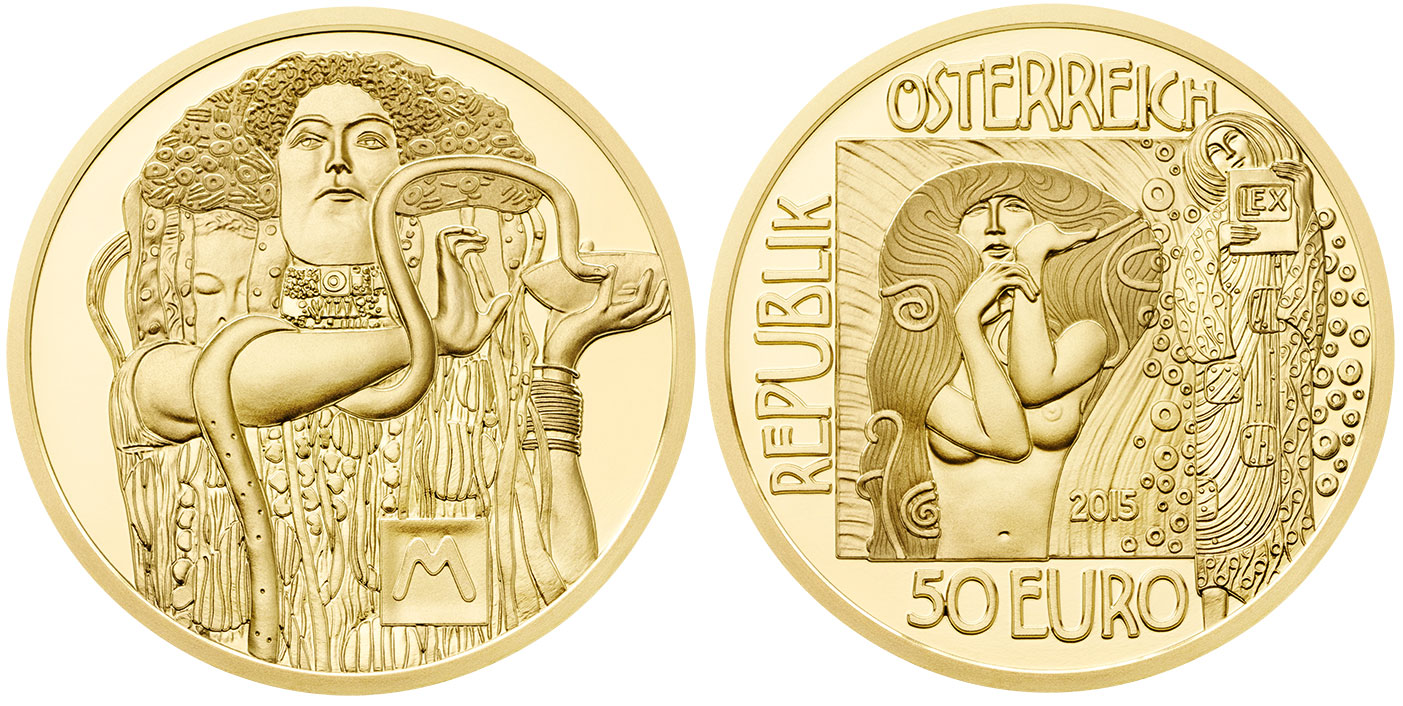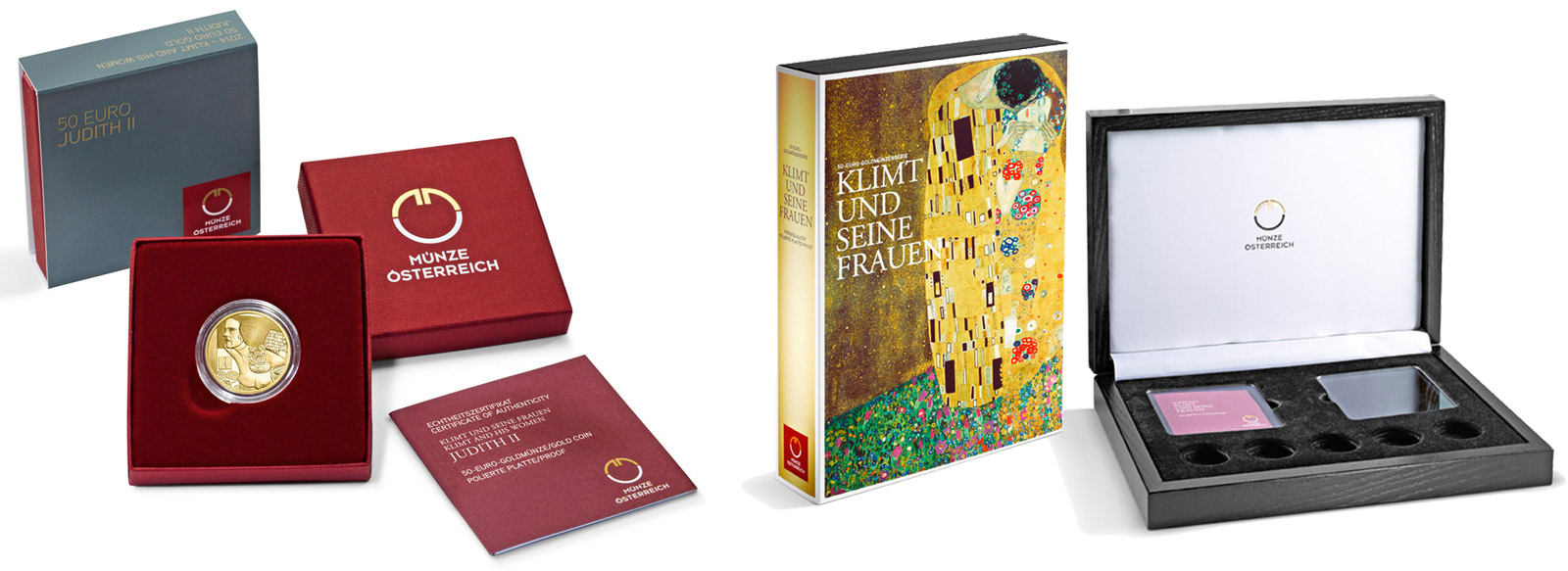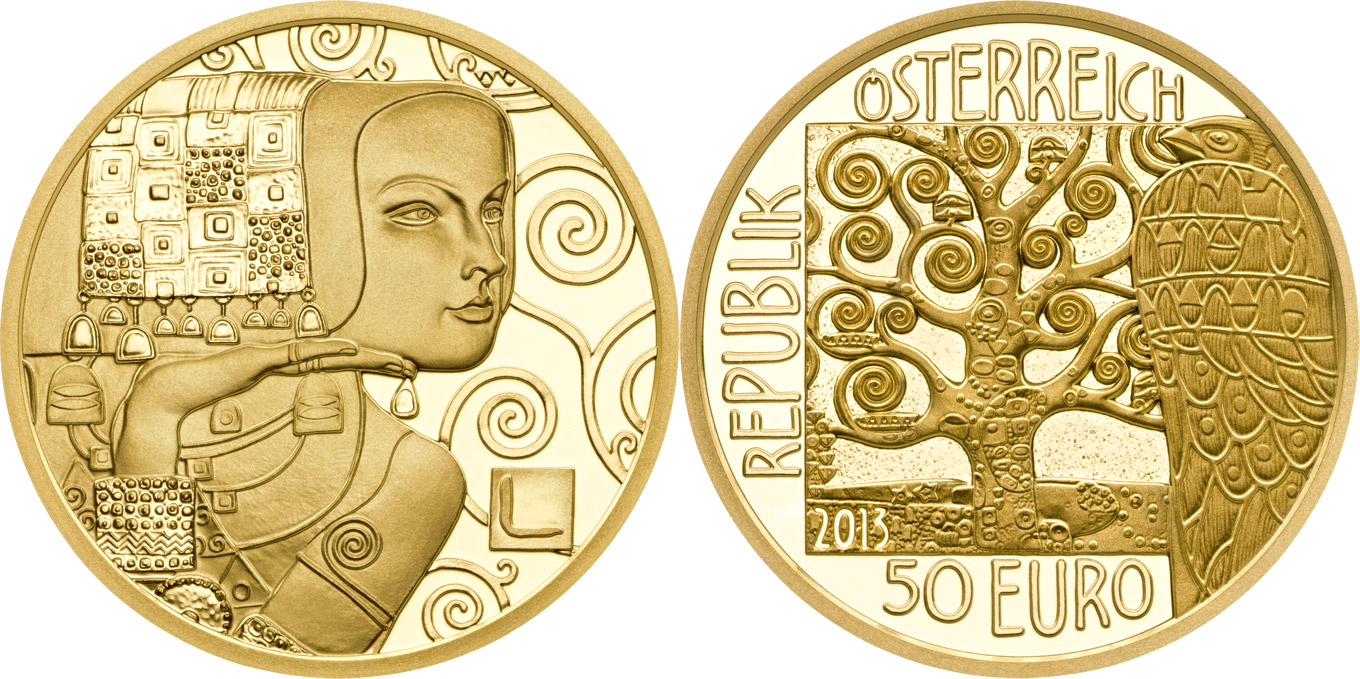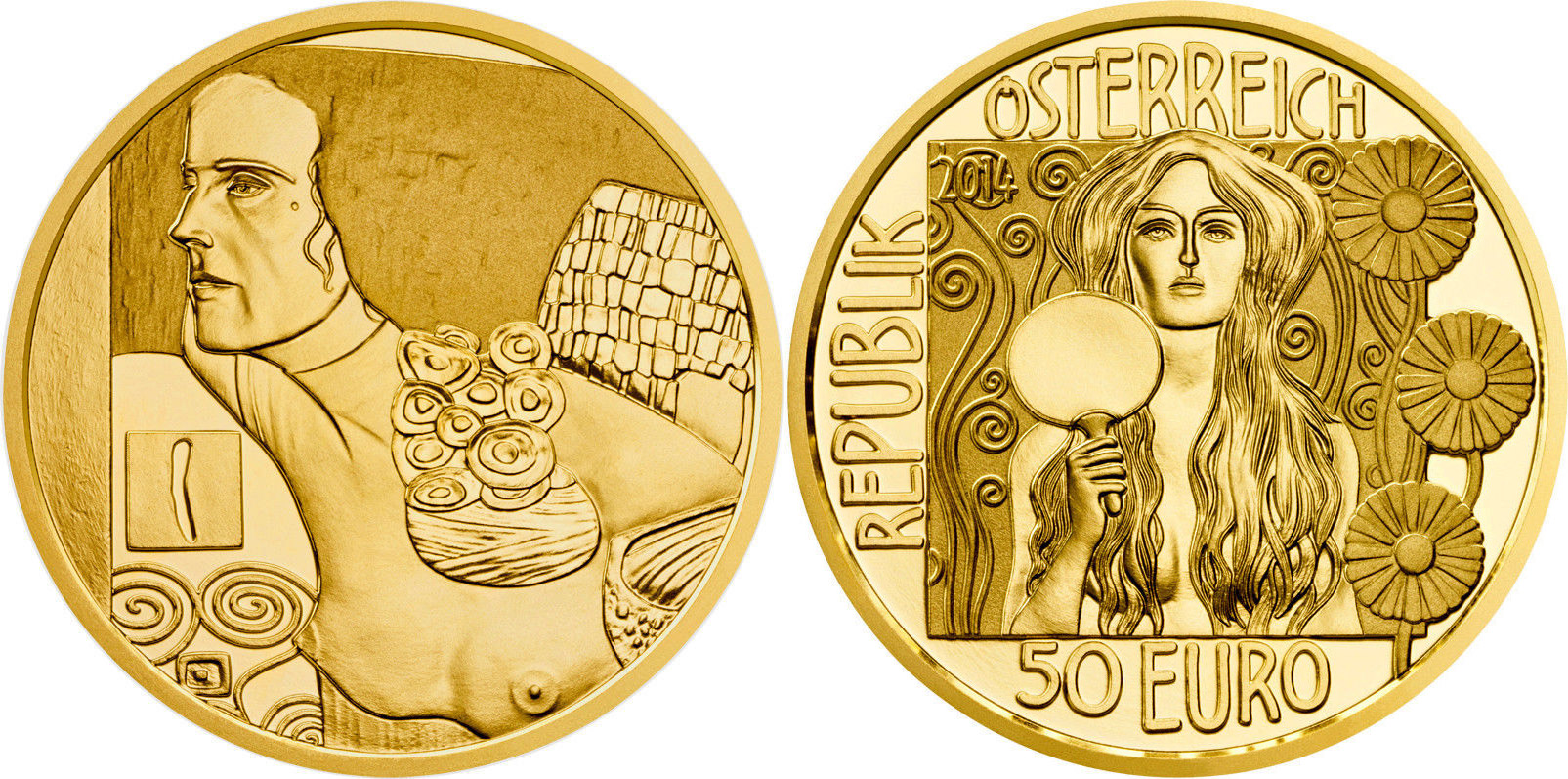Starting back in 2012, the Austrian Mint embarked on a new five-coin series featuring Gustav Klimt’s paintings, specifically from a particular phase of his career when women were the focus of his attention, called his “golden phase”. Titled Klimt and his Women, the 10g proof finish coins are exquisitely designed and closely tied with some of his most famous works.
The second coin in the series, The Expectation, was the recent winner of the 2015 Krause Publications coin of the year award. There’s usually quite a bit of debate over the winning coin being good enough to take the prize, but there’s been little dissent over this one, indicating that it’s seen to be a deserving choice.
This coin is based on the second of three paintings in his series, Philosophy, Medicine and Jurisprudence, and was presented in March 1901 at the tenth Viennese Secession Exhibition. Criticised at the time for displaying an ambiguous unity of life and death, with nothing to celebrate the role of medicine or the science of healing, an editorial in the Medizinische Wochenschrift complained that the painter had ignored doctors’ two main achievements, prevention and cure. Like the other two works in the series, it was destroyed in 1945 by retreating SS soldiers in what can only be described as outright artistic vandalism.
Struck in Proof quality with a maximum mintage of 30,000, each coin comes in a case complete with a numbered certificate of authenticity. A superb wooden presentation case is also available at €66 for those keen to complete the entire five-coin Klimt and his Women collection. Designed by Mag. Helmut Andexlinger and Herbert Wahner, the coin is shipping from the 15th April and sells for €450.00, up from last years €405.00, but down from the first two coins at €505.00 and €510.00.
Gustav Klimt was no stranger to controversy, but the outrage caused by his Faculty Paintings was even debated in the Austrian Parliament and became a political issue. The paintings were never actually used for their intended purpose as Klimt returned his fee and refused to deliver his artworks, which were eventually burnt by the Nazis at the end of the Second World War. A detail from Klimt’s Jurisprudence, in the form of the Eumenides, the Greek deities of vengeance, graces the coin’s obverse. Stylised snakes accentuate Klimt’s customary swirling patterns of the gorgon’s hair in the rectangular centre, while to the right stands the goddess of law. The reverse shows a detail from Medicine as Hygieia, daughter of the Greek god of medicine, with the Aesculapian snake wound around her arm and the cup of Lethe in her hand. The letter M, the fourth letter in the word “Klimt”, appears at the foot of the coin.
GUSTAV KLIMT: THE ARTIST
Gustav Klimt (July 14, 1862 – February 6, 1918) was an Austrian symbolist painter and one of the most prominent members of the Vienna Secession movement. He remained with the Secession until 1908. The goals of the group were to provide exhibitions for unconventional young artists, to bring the works of the best foreign artists to Vienna, and to publish its own magazine to showcase the work of members. It was while a member that Klimt entered what has become known as his ‘Golden Phase’, many of his paintings containing gold leaf.
Klimt’s paintings have brought some of the highest prices recorded for individual works of art. In November 2003, Klimt’s Landhaus am Attersee sold for $29,128,000, but that sale was soon eclipsed by prices paid for other Klimts. In 2006, the 1907 portrait, Adele Bloch-Bauer I, was purchased for the Neue Galerie New York by Ronald Lauder reportedly for US $135 million, surpassing Picasso’s 1905 Boy With a Pipe (sold May 5, 2004 for $104 million), as the highest reported price ever paid for a painting.
On August 7, 2006, Christie’s auction house announced it was handling the sale of the remaining four works by Klimt that were recovered by Maria Altmann and her co-heirs after their long legal battle against Austria. The portrait of Adele Bloch-Bauer II was sold at auction in November 2006 for $88 million, the third-highest priced piece of art at auction at the time.
The Apple Tree I (ca. 1912) sold for $33 million, Birch Forest (1903) sold for $40.3 million, and Houses in Unterach on Lake Atter (1916) sold for $31 million. Collectively, the five restituted paintings netted more than $327 million. An unremarkable Attersee painting fetched $40.4 million at Sotheby’s in November 2011.
Klimt died in Vienna on February 6, 1918, having suffered a stroke and pneumonia due to the influenza epidemic of that year.
KLIMT AND HIS WOMEN: SERIES TO DATE
2012 COIN 01: ADELE BLOCH-BAUER
Completed in 1907, the painting took longer than any of Klimt’s other works to finish and features the only model to be painted more than once by the Viennese master – the wife of wealthy industrialist and patron of the arts Ferdinand Bloch-Bauer. Ethereal and enigmatic, the portrait was created from oils and gold leaf, which is why it has been possible to reproduce it so magnificently on the reverse of this 50 euro gold coin. The elaborate Jugendstil ornamentation of the painting’s background provides an intricate contrast to the smoother relief of the subject’s head in the foreground. A handsome portrait of the artist himself is reproduced in profile on the coin’s obverse to similar effect.
Designed by Thomas Pesendorfer and Herbert Wahner.
2013 COIN 02: THE EXPECTATION
Clearly inspired by Egyptian art, The Expectation is a prime example of how Klimt found inspiration in the past yet succeeded in creating something completely modern and original. It also exemplifies Klimt‘s trademark swirling decorative designs, as does The Tree of Life on the coin‘s obverse. Both pictures are mosaics from Klimt‘s famous frieze on the walls of the Palais Stoclet in Brussels. Commissioned by the wealthy Belgian banking family who owned the Palais, work on the Stoclet Frieze was actually undertaken by the Wiener Werkstätte, the ground-breaking Viennese modernist workshop of visual artists.
Designed by Thomas Pesendorfer and Mag. Helmut Andexlinger.
2014 COIN 03: JUDITH II
Painted in 1909, the life-size portrait shows a gaunt and bushy-haired Judith looking to her right as she clutches the severed head of Holoferenes, an Assyrian general who was threatening to destroy her home city of Bethulia. Klimt’s customary swirling art nouveau ornamentation features on this side of the coin as well as on its obverse, which is graced with Nuda Veritasfrom Klimt’s golden phase. Painted in 1889, the long-haired beauty holding a mirror shows artistic truth without compromise and is a perfect example of Klimt’s artistic vision. This was a vision that led the painter to co-found the Vienna Secession, the artistic movement that rejected the conservatism of the early 20th-century Viennese art world.
Designed by Thomas Pesendorfer and Herbert Wahner.
| SPECIFICATION | |
|---|---|
| DENOMINATION | €50 EURO |
| COMPOSITION | 0.986 GOLD |
| WEIGHT | 10.14 g (10.00g fine) |
| SIZE | 22.0 mm |
| FINISH | PROOF |
| MINTAGE | 30,000 |
| ARTIST | THOMAS PESENDORFER / HERBERT WAHNER |
| BOX / COA | YES / YES |








Leave A Comment